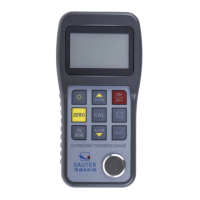3.2 Conditions and preparations for surfaces
For any kind of ultrasonic measurement, the condition and roughness of the surface to
be measured is of utmost importance. Rough, uneven surfaces can
restrict the penetration of the ultrasonic waves through the material, resulting in
unstable, incorrect measurement results
The surface to be measured should be clean and free of any substances, rust or
verdigris. If this is the case, the sound generator cannot be cleaned
can be placed on the surface. A wire brush or scraper is often helpful to clean the
surface. In extreme cases, belt sanders or the like can be used. However, it is important
to avoid gouging the surface, which prevents the sound generator from being placed
cleanly.
Extremely rough surfaces like siliceous cast iron are very difficult to measure. These
types of surfaces behave like when light shines on frosted glass, the beam is scattered
and sent in all directions.
In addition, rough surfaces contribute to considerable wear of the sounders, especially
in situations where they are "scrubbed" over the surface.
They should therefore be checked at a certain distance, especially at the first signs of
unevenness on the contact surface. If it is worn down more on one side than the other,
the sound waves can no longer penetrate vertically through the material surface of the
test object. In this case, small irregularities in the material are difficult to measure
because the sound beam is no longer exactly below the sound source.
4. Mode of operation
4.1 Switching on and off
The device is switched on and off by the on/off button.

